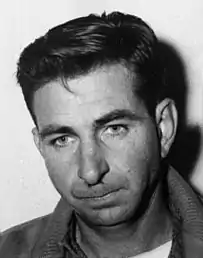Herman Tucker
Herman Tucker (September 2, 1928 – March 14, 2001) was an American truck driver and heavy equipment operator. He was allegedly linked to the murders of Chaney, Goodman, and Schwerner who were murdered by the Ku Klux Klan in June 1964. The bodies of the civil rights workers were found buried in an earthen dam on Olen Burrage's farm that Tucker had helped to construct.
Herman Tucker | |
|---|---|
 Late 1964 mugshot of Tucker | |
| Born | September 2, 1928 |
| Died | March 14, 2001 (aged 72) |
| Occupation(s) | Heavy equipment operator, truck driver |
| Criminal status | Acquitted |
| Spouse | Catherine Tucker |
| Criminal charge | Conspiring to injure, oppress, threaten, and intimidate |
Background
Tucker was a born in and was a lifelong resident of Neshoba County, Mississippi. He was a veteran of the United States Army. At the time of the murders, Tucker lived with his wife in the Hope community found a few miles west of Philadelphia. Tucker was never identified by a witness or informant as a Klan member.[1]
Freedom Summer Murders
In the afternoon of June 21, 1964, Chaney, Goodman, and Schwerner arrived at Longdale to inspect the burned out church in Neshoba County. They left Longdale around 3 p.m. They were to be in Meridian by 4 p.m. that day. The fastest route to Meridian was through Philadelphia. At the fork of Beacon and Main Street their station wagon sustained a flat tire. It is possible that a shot was fired at the station wagon's tire. Rainey's home was near the Beacon and Main Street fork. Deputy Cecil Price soon arrived and escorted them to the county jail. Price released the trio as soon as the longest day of the year became night which was about 10 p.m. The three were last seen heading south along Highway 19 toward Meridian.
The disappearance of the three men was initially investigated as a missing persons case. The civil rights workers' burnt-out car was found near a swamp three days after their disappearance.[2][3] An extensive search of the area was conducted by the Federal Bureau of Investigation (FBI), local and state authorities, and four hundred United States Navy sailors.[4] The three men's bodies were not discovered until two months later, when the team received a tip. During the investigation it emerged that members of the local White Knights of the Ku Klux Klan, the Neshoba County Sheriff's Office, and the Philadelphia Police Department were involved in the incident.
Burrage's Dam
Burrage was developing a cattle farm called the Old Jolly Farm on Highway 21 which was a few miles southwest of Philadelphia.[5] Tucker was a part-time truck driver for Burrage and owned two Caterpillar bulldozers.[5] Burrage contracted Tucker to clear an area on his farm for a pond and to build an earthen dam.[6]
Sometime before the murders, Burrage remarked about the "invasion" of Civil Rights workers coming to Mississippi. Burrage allegedly proclaimed that, "Hell, I've got a dam that'll hold a hundred of them."[7]
Arrest
After being indicted by federal grand jury in December 1964, Tucker was placed under arrest by the Federal Bureau of Investigation for violation of Title 18, Section 241, United States Code.
Tucker was officially arrested at 9:02 a.m., December 4, 1964, and transported to the Naval Auxiliary Air Station, Meridian, Mississippi where he was taken to the Bachelor Officers Quarters on the base where he was interviewed, fingerprinted and photographed. Tucker was ultimately acquitted in 1967.[8]
Death
Tucker died at his home in Neshoba County, Mississippi.
See also
References
- Cagin, Seth; Philip Dray (1988). "June 21, 1964". We Are Not Afraid. Bantam Books. p. 359.
- ""Mississippi Burning" murders". CBS News. Retrieved December 16, 2015.
- Bayless, Les. "Three who gave their lives: Remembering the martyrs of Mississippi Freedom Summer, 1964". People's Weekly World. Retrieved December 1, 2016.
- "We're Stymied, Rights Search Leaders Admit". Desert Sun. No. 283. UPI. July 1, 1964. Retrieved December 1, 2016.
- Cagin, Seth; Philip Dray (1988). "June 21, 1964". We Are Not Afraid. Bantam Books. p. 55.
- Cagin, Seth; Philip Dray (1988). "June 21, 1964". We Are Not Afraid. Bantam Books. p. 359.
- Cagin, Seth; Philip Dray (1988). "June 21, 1964". We Are Not Afraid. Bantam Books. p. 341.
- "Mississippi Burning Trial: The Jury's Decision".